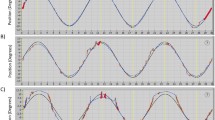Abstract
Aim: The aim of this study was to assess the relationship between oculomotor synergies and brain oxygen status at mild traumatic brain injury (mTBI) using simultaneous comparison of eye-tracking (ET) parameters and cerebral oxygen saturation.
Material and methods: This non-randomised single-centre prospective study included 77 patients with mTBI (mean age was 36.3 ± 4.8 years, 48 men, 29 women, median GCS 13.7 ± 0.7). Cerebral oximetry was used to detect oxygen saturation level (SctO2) in the frontal lobe pole (FLP) region. Eye movements were measured simultaneously using the EyeTracker. Calculated parameters were: vertical and horizontal angular eyeball velocity (AV); left vertical speed (LVS); right vertical speed (RVS); left horizontal speed (LHS); and right horizontal speed (RHS). The indices of vertical and horizontal eye version (version index, Vx) were calculated as the Pearson correlation coefficient between the corresponding AV of the right and left eyes. Significance was pre-set to p < 0.05.
Results: SctO2 in the FLP varied from 62% to 79%. The average SctO2 values were 69.26 ± 6.96% over the left FLP and 70.25 ± 7.58% over the right FLP (p = 0.40). The total analysis of the eye-tracking data revealed the following values of gaze parameters: LVS – 0.327 ± 0.263 rad/sec; LHS – 0.201 ± 0.164 rad/sec; RVS – 0.361 ± 0.269 rad/sec; and RHS – 0.197 ± 0.124 rad/sec. The calculated vertical version index (VVx) was 0.80 ± 0.12. The calculated horizontal version index (HVx) was 0.82 ± 0.11. The VVx and HVx were correlated with SctO2 levels in the FLP (p = 0.038; r = 0.235; p = 0.048; r = 0.218, respectively p = 0.035; r = 0.241; p = 0.039; r = 0.235, respectively). Conclusions: VVx and HVx correlate with the SctO2 level in the FLP (p < 0.01) in mTBI. No significant correlation was detected between the level of the SctO2 level and vertical and horizontal AV of the eyeballs. Eye tracking can help quantify the severity of ocular conjugation impairments after mTBI, as well as explore the contribution that cerebral oxygen status disorders make to this process.
Access this chapter
Tax calculation will be finalised at checkout
Purchases are for personal use only
Similar content being viewed by others
References
Astafiev SV, Shulman GL, Metcalf NV et al (2015) Abnormal white matter blood-oxygen-level-dependent signals in chronic mild traumatic brain injury. J Neurotrauma 32(16):1254–1271
Murray NP, Claire-Marie Roberts MH, Tyagi A et al (2021) Oculomotor training for poor saccades improves functional vision scores and neurobehavioral symptoms. Arch Rehabil Res Clin Transl 3(2):100126
Hunfalvay M, Roberts C, Murray N et al (2019) Horizontal and vertical self-paced saccades as a diagnostic marker of traumatic brain injury. Concussion (London, England) 4(1):CNC60
Cifu DX, Wares JR, Hoke KW et al (2015) Differential eye movements in mild traumatic brain injury versus normal controls. J Head Trauma Rehabil 30(1):21–28
Trofimov AO, Kalentiev G, Voennov O et al (2016) Comparison of cerebral oxygen saturation and cerebral perfusion computed tomography in cerebral blood flow in patients with brain injury. Adv Exp Med Biol 876:145–149
Mucha A, Collins M, Elbin R et al (2014) A brief vestibular/ocular motor screening (VOMS) assessment to evaluate concussions. Am J Sports Med 42(10):2479–2486
Contreras R, Ghajar J, Bahar S et al (2011) Effect of cognitive load on eye-target synchronization during smooth pursuit eye movement. Brain Res 1398(29):55–63
Sussman E, Ho A, Pendharkar A, Ghajar J (2016) Clinical evaluation of concussion: the evolving role of oculomotor assessments. Neurosurg Focus 40(4):E7
Piper C, Fortune B, Cull G et al (2013) Basal blood flow and autoregulation changes in the optic nerve of rhesus monkeys with idiopathic bilateral optic atrophy. Invest Ophthalmol Vis Sci 54(1):714–721
Wetzel P, Lindblad A, Mulatya C et al (2019) Eye tracker outcomes in a randomized trial of 40 sessions of hyperbaric oxygen or sham in participants with persistent post concussive symptoms. Undersea Hyperb Med J Undersea Hyperb Med Soc Inc 46(3):299–311
Wagner M, den Boer M, Jansen S et al (2022) Video-based reflection on neonatal interventions during COVID-19 using eye-tracking glasses: an observational study. Arch Disease Child. Fetal Neonatal Ed 107(2):156–160
Peißl S, Wickens D, Baruah R (2018) Eye-tracking measures in aviation: a selective literature review. Int J Aerosp Psychol 28(3–4):98–112
Acknowledgments
AT and KT were supported by a Grant-in-Aid for Exploratory Research from the Privolzhsky Research Medical University. OSG was supported by RSF 20-15-00090, RSF 19-15-00201, grant 075-15-2019-1885; DB was supported by NIH R01 NS112808.
Author information
Authors and Affiliations
Editor information
Editors and Affiliations
Rights and permissions
Copyright information
© 2022 Springer Nature Switzerland AG
About this paper
Cite this paper
Trofimov, A.O. et al. (2022). Eye Tracking Parameters Correlate with the Level of Cerebral Oxygen Saturation in Mild Traumatic Brain Injury: A Preliminary Study. In: Scholkmann, F., LaManna, J., Wolf, U. (eds) Oxygen Transport to Tissue XLIII. Advances in Experimental Medicine and Biology, vol 1395. Springer, Cham. https://doi.org/10.1007/978-3-031-14190-4_26
Download citation
DOI: https://doi.org/10.1007/978-3-031-14190-4_26
Published:
Publisher Name: Springer, Cham
Print ISBN: 978-3-031-14189-8
Online ISBN: 978-3-031-14190-4
eBook Packages: Biomedical and Life SciencesBiomedical and Life Sciences (R0)




